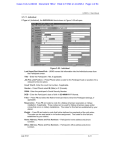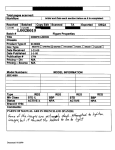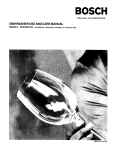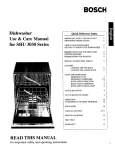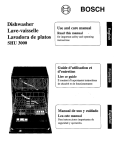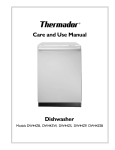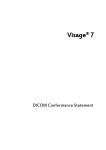Download Bosch SHI 4300 Operating instructions
Transcript
BOSCH
Dishwasher
Use & Care Manual
SHU 3300 Series
SHU 4300 Series
SHI 4300 Series
SHV 4300 Series
SHV 4800 Series
SHU 9900 Series
Quick Reference
Index
IMPORTANT SAFETY INSTRUCTIONS
GROUNDING INSTRUCTIONS
2
2
ABOUT YOUR DISHWASHER
GETTING TO KNOW YOUR DISHWASHER
3
3
BEFORE USING FOR THE FIRST
GETTING STARTED
PREPARATIONS
FOR WASHING
5
5
5
TIME
SPECIAL INSTRUCTION, TABLE 1
6
LOADING
LOADING THE TOP RACK
LOADING THE LOWER RACK
5
7
RACK HEIGHT ADJUSTMENT
7
EXTRA TALL ITEMS
8
USING THE DISPENSERS
DETERGENT USE
DETERGENT DISPENSER
RINSE AGENT DISPENSER
RINSE AGENT INDICATOR
RINSE AGENT REGULATOR
8
9
9
10
10
CYCLE SELECTION
1o
OPERATION
TO INTERRUPT OR RESET CYCLE
10-11
10-11
CYCLE
12-13
SELECTION
CHART
UNLOADING
13
CARE
14
& CLEANING
SERVICE
and REPAIR
15
SELF-HELP
16
WARRANTY
17
\
READ THIS MANUAL
for important safety and operating instructions
IMPORTANT
SAFETY INSTRUCTIONS
WARNING -- When using your dishwasher, basic safety precautions should always be followed to
reduce the risk of fire, electric shock, and/or injury to persons, including the following:
1. Bosch dishwashers are provided with two manuals; one, Installation Instruction Manual and
one, Care and Use Manual. Read all instructions before using the dishwasher.
2. Use the dishwasher only for its intended function.
3. Use only detergents or wetting agents recommended for use in a dishwasher and keep them out
of the reach of children.
4. When loading items to be washed:
a. Locate sharp items so that they are uot likely to damage the door seal,
and
b. Load sharp knives with the handle up to reduce the risk of cut-type injuries.
5. Do not wash plastic items unless marked "dishwasher safe" or the equivalent. For plastic items
not so marked, check the manufacturer's recommendations.
6. Do not touch the heating element during or immediately after use.
7. Do not operate your dishwasher unless all the enclosure panels are properly in place.
8. Do not tamper with controls.
9. Do not abuse, sit on, or stand on the door or dish rack of the dishwasher.
10. To reduce the risk of injury, do not allow children to play in or on the dishwasher.
11. Under certain conditions, hydrogen gas may be produced in a hot water system that has not
been used for two weeks or more. Hydrogen gas is explosive. If the hot water system has not
been used for such a period, before using the dishwasher turn on all hot water faucets and let
the water flow from each for several minutes. This will release any accumulated hydrogen gas.
As the gas is flammable, do not smoke or use an open flame during this time.
12. Remove the door to the washing compartment when removing an old dishwasher from service
or discarding.
WARNING -- This dishwasher must be grounded in accordance with the National Electrical Code
and/or local codes. These must be carefully followed in all cases. See Installation Instructions
provided with this dishwasher for complete installation information. Make sure this dishwasher has
been properly grounded and installed by a qualified installer before using.
SAVE THESE INSTRUCTIONS
GROUNDING
INSTRUCTIONS
This appliance must be connected to a grounded metal, permanent wiring system; or an equipment
grounding conductor must be run with the circuit conductors and connected to the equipment
grounding terminal or lead on the dishwasher.
HOUSEHOLD
USE ONLY
ABOUT YOUR DISHWASHER
Congratulations on having selected a BOSCH
dishwasher, the choice of those that demand quiet and
exceptional cleaning performance from their dishwasher.
The Bosch dishwashers listed in this manual offer the
following features:
•
Stainless steel inner liner and inner door
•
Exceptionally low water consumption
•
Four spraying levels
•
Height adjustable upper rack
•
Mulfi-functional upper and lower rack
•
•
•
•
•
Flow-Through Heater TM for temperature boosting
Triple tilter system
Top Rack Only TM (SI-IV 4800 only)
"Refill rinse agent" indicator lamp (SHV 4800 only)
Cycle Completion Signal (SHU 9900 only)
GETTING TO KNOW YOUR DISHWASHER
Figure 1, below, is an illustration of the dishwasher with its
features called out.
Upper Spray Arm
Upper Rack
Door Gasket
Lower Spray Arm
Filters
Lowa
eck
Detergent Dispenser
Agent Dispenser
Name/Rating
Plate
(on dght side of door)
_1.
GENERAL INFORMATION
This manual covers the following dishwashers:
•
SHU 9900
The SHU 9900 model has the control panel located on
the top edge of the door. This unit is provided with a
full door and handle assembly. Additional accessory
door panels can not be used with this model.
•
SHV 4300 and SHV 4800
The above listed models have the controls mounted on
when the door is open. The unit is designed to accept a
full custom door panel.
SHI 4300
This model has a standard control panel. The lower
portion of the door is designed to accept a custom
door panel.
SHU 3300 and 4300
These models have a standard control panel and a
standard door panel.
the top edge of the door. The controls are only visible
_'_
BOSCH
_,
_-
._,
0
0
P_
0
0
o_
SHU 3300 control panel
Or_OffButton
tY_d
wv_
0
SHU 4300 series & SH14300 series
control panel
J
Hm.e
0
0
0
0
P,4mo_y
0
0
/
I
SHV 4300 control panel
J
I
SHV 4800 control panel
J
SHU 9900 control panel
4
I
BEFORE USING FOR THE FIRST TIME
Before beginning to use your dishwasher for the first
time:
1. Check to make sure that the voltage on which the
dishwasher is to operate is the same as shown on
the rating plate.
GETTING STARTED
The operation of your Bosch dishwasher is summarized
below:
l, Load the dishwasher.
Refer to Table I for items suitable for washing in the
dishwasher. The dishwasher should be loaded with
pots, pans, dishes and silverware according to the
instructions provided under the following section
tiffed LOADING.
2.
3.
Add detergent and check rinse agent.
Detergent must be placed in the detergent dispenser
compartment as described in the following section
titled DETERGENT USE. The use of a rinse agent is
required to ensure good cleaning and drying result.
See section titled RINSE AGENT DISPENSER.
Check motion of wash arms.
The wash arms must be free to move and should not
be blocked by any item extending so far above lower
rack as to block upper ann or by any items hanging
below either the upper or lower rack to obstruct the
motion of the wash arms. See section titled
OPERATION to start the dishwasher.
PREPARATIONS FOR WASHING
Very l'tttle preparation is required before placing dishes,
pots, pans, etc. into the dishwasher. However, some
preparation is required:
•
Large solids, such as, bones, large seeds, shells, skins,
leafy vegetables, meat trimmings, etc. should be
removed either by scraping into a wastebasket, or into
your food disposer.
•
Large amounts of any type of leftover food should
also be scraped into a wastebasket or into your food
disposer.
•
Pots and pans that have burned-on food, the food is
blackened, should be pre-soaked and scoured. The
dishwasher cannot remove burned-on food.
•
2. Check to make sure that the water valve to the
dishwasher is open. The installer may have closed
the valve upon completing the installation.
LOADING
LOADING THE TOP RACK
The upper rack of the dishwasher has been designed with
flexibility in mind. Glasses, cups, plates, bowls and
small pots may be loaded in many different positions to
fit your needs. Figure 3, shows a typical mixed load for
an upper rack washing load.
The dishwasher should be loaded so that water can
circulate freely and reach every part of every item that is
to be cleaned:
•
Cups, glasses and containers should be placed in upper
rack upside down so that water does not collect in
them. Tall narrow vessels, such as a vase or tall
glass,
should be placed in the lower rack, near the middle,
for the best cleaning result.
•
The Bosch dishwashers have a special feature
incorporated into the flip down cup shelves on the
side of the upper rack. The ends of these shelves are
specially formed to help maintain spacing between
stemmed glasses. When in the flipped down position
long stemmed glasses may be placed in the second
row from the edge and placed so their stems rest in
the "V" formed ends of the shelves. When the cup
shelves are in the up position long stemmed glasses
may be placed in the first row with their stems placed
to rest between the tooth like projections of the
shelves.
•
China, crystal and other delicate items must be placed
so that they do not touch each other during dishwasher
operation. Chipping or other damage may occur.
Do not place the following items in the dishwasher:
> toothpicks
> small bones and bone slivers
> paper products such as paper plates and paper
napkins
> plastic bags or plastic packaging material.
In general, try to remove food scraps and place the items
to be washed in the dishwasher before the food has had a
chance to dry-on. Dried-on food is more difficult to
remove. If there will be an extended period of time before
the dishwasher will be run it is recommended that the
RINSE & HOLD cycle be used.
Other than the above, no special preparation or pre-rinsing
is required for dishes, pots and pans or utensils with
normal amounts of food soil.
_3.
At completion of loading of the upper rack check to
make sure that nothing is protruding through or
hanging beneath the bottom of the rack, which could
block the rotation of the spray ann.
5
MATERIAL
DISHWASHER
USE
COMMENTS AND/OR SPECIAL INSTRUCTIONS
ADHESIVE
JOINED ITEMS
NOT
RECOMMENDED
Items joined by adhesives, whether plastic, wood, bone, steel, copper or
tin, etc. may be loosened.
ALUMINUM
USUALLY SAFE
Colored anodized aluminum may fade over time. Minerals in the water may
cause spotting or darkening of aluminum. This can usually be removed by
scouring with a soap filled steel wool pad.
BONE
HANDLED
UTENSILS
NOT
RECOMMENDED
Handles may separate.
CHINA &
STONEWARE
USUALLY SAFE
It is highly recommended however that "on-glaze" decorated china,
handpainted and gold or platinum trimmed, or antique china or stoneware
be hand washed. If there is may doubt, please check with the manufacturer
of your set or test by washing one piece with each load for a month and
comparing this piece with the rest of the set to determine if there has been
any fading or discoloration.
CRYSTAL
USUALLY SAFE
Decorated crystal, those handpalnted, "on-glaze", or metal trimmed, may
discolor, fade, or spot. It is recommended that these be hand washed. Also,
fragile glassware is highly breakable, be sure to set the pieces so that they
do not topple during washing and so that they do not knock against other
pieces.
GLASS
USUALLY SAFE
Milk glass may yellow.
NON-STICK
COATINGS
USUALLY SAFE
After drying the non-stick coating should be covered with a light coating of
vegetable oil.
IRON
NOT
RECOMMENDED
Iron will rust. Wash by hand and dry immediately.
PEWTER
NOT
RECOMMENDED
Pewter will tarnish. Wash by hand and dry immediately.
PLASTIC
USUALLY SAFE
Only wash "dishwasher safe" plastic items.
STAINLESS
STEEL
USUALLY SAFE
Do not let stainless steel items contact copper or sterling silver or
silverplate items.
STERLING
SILVER &
SILVERPLATE
USUALLY SAFE
Do not allow to come in contact with stainless steel or copper items.
TIN
NOT
RECOMMENDED
Tin will rust. Wash by hand and dry immediately,
WOOD
NOT
RECOMMENDED
Wooden bowls, wooden utensils and wood handled utensils can warp, crack
or lose their finish.
NONDISHWARE
ITEMS
NOT
RECOMMENDED
The Bosch dishwasher is only intended for use in cleaning standard
household dishware items.
Table 1.
6
Silverware should be placed in the silverware basket
with the handles down, with the exception of the
knives, which in order to avoid accidentally cutting
oneself, should be placed with the handles up.
If you do inadvertently load the silverware basket with the
knife blades up it is recommended, to avoid cutting
yourself when unloading, that you remove the silverware
basket from the dishwasher and tip the contents out onto
a cutting board.
RACK HEIGHT ADJUSTMENT
The upper rack height of the Bosch dishwashers is
adjustable. There are two positions, see figure 6:
1. The upper position is used to provide more room for
items to be placed in the lower rack.
2. The lower position is used to provide more room for
items to be placed in the upper rack.
Figure 4.
LOADING THE LOWER RACK
•
Large and/or heavily soiled items should be placed in
the lower rack of the dishwasher. Heavily soiled pots
and pans should be placed face down. See figure 4.
•
If more space is needed for pots and pans the rear
two sets of tines can be folded to the down position on
all models, or the rear three sets of tines on the DLX
models. Figure 5 shows lower basket with two rear
sets of tines in the down position to accommodate
large pots.
•
Silverware should be mixed when placed in the
silverware basket. The purpose of mixing the
silverware is to avoid having them nest together, for
example if spoons would be placed together they
could nest together so that water could not properly
circulate across them to clean the surfaces.
Figure 6.
To repositiou rack:
a. First empty upper rack and pull rack partially out to
point where rack can be lifted upward as shown in
upper illustration of Figure 6.
b. Pull the rack forward and then up until rollers are
completely free of channels.
c. Reinsert the rack with the other set of rollers on the
channel.
Figure 5.
EXTRA TALL ITEMS
ff you have extra tall items that cannot fit in the lower rack
without interfering with the upper spray arm or without
hitting the upper rack, the upper rack may be removed. A
special "Extra Tall Item Sprinkler" is provided with the
dishwasher to allow use of the dishwasher with upper rack
removed. See figure 7.
To allow washing of extra tall items:
1. With upper rack empty, remove it from the dishwasher
by pulling the rack partially out to the point where
rack can be lifted upward and out to disengage the
wheels from the side rails.
2.
Place the "Extra Tall Item Sprinkler" over the upper
rack spray outlet at the back of the dishwasher tub
(refer to figure 7) and tam clockwise to lock sprinkler
head in place.
Figure 8.
USING THE DISPENSERS
For the best washing result it is important to use the correct
amount of detergent and rinse agent.
DETERGENT USE
Use only fresh dishwashing detergent (powder is recommended) manufactured specifically for dishwasher use. Use
of other types of detergents will result in excessive suds.
Be sure to check the phosphate content of the detergent to
be used. Phosphate helps prevent the minerals in hard
water from forming a film or spots on dishes. Hard water
requires your detergent to work harder. In hard water areas
you will find that detergents with high phosphate levels
will provide a better result. If the phosphate level is low,
below 8.7%, you may have to use extra detergent in hard
water
areas.
Figure 7.
Extra tall items may now be placed in lower rack for
washing, as shown in figure 8. To remove "Extra Tall Item
Sprinkler", to again allow use of upper rack, reverse
actions used to insert it.
Figure 9.
Be sure to follow the dishwasher detergent manufacturer's
instructions when using the detergents. Concentrated
detergents usually call for lower usage than do standard
detergents.
Note:
Do not use detergent when the RINSE & HOLD
cycle has been selected.
DETERGENT
DISPENSER
The detergent dispenser on the Bosch dishwasher is
located on the inside of the door, see figure 1 as well as
figure 9 and 10. The detergent dispenser cover may be
opened by pulling the release tab (figure 10) toward you.
After filling the detergent compartment close the cover
by sliding it over the detergent chamber and pressing
down on the button until it clicks shut. The detergent will
be dispensed automatically during the wash portion of the
cycle.
If the cover of the detergent dispenser is closing fully but
it won't latch this is most likely due to the dishwasher
having been stopped in mid cycle. Check the cycle
progress lights (see Figure 2) to see if cycle has been
completed. If the cycle has been completed the "CLEAN"
light will be illuminated. If the cycle is not complete please
refer to section of this manual titled TO INTERRUPT
OR RESET CYCLE to reset cycle.
Once the cover is open you will see two level marks:
"25" and "15". These refer to the volume when filled level
in milliliters. 15 milliliters is equivalent to 3 teaspoons. If
the detergent dispenser is completely filled it can hold
45 milliliters, or roughly 9 teaspoons.
The amount of detergent to be used depends on the cycle
selected and the water hardness:
•
For water of medium hardness and REGULAR WASH
•
•
cycle it is recommended that the detergent dispenser
be filled to the 25 milliliters, (5 tsp.) level.
With hard water, or with the POWER SCRUB PLUS
cycle, it is recommended that the detergent dispenser
be completely filled, roughly 9 teaspoons. If additional
detergent is required it can be placed on the inside of
the door, just below the dispenser.
With soft water the amount of detergent may be
reduced.
Rinse Agent Level Indicator
_11.
RINSE AGENT DISPENSER
Rinse agent, or a rinse aid, is used to diminish water
spotting and to provide optimum drying results. It is
recommended that a rinse agent be used at all times with
the Bosch dishwasher. In a Bosch dishwasher the rinse
agent not only serves to rinse the dishware, but also serves
to rinse the tank and inner door of the dishwasher.
The rinse agent dispenser is located next to the detergent
dispenser. See figure 11. Rinse agent is available in liquid
or solid form. Do not use the solid type of rinse agent in
the Bosch dishwasher.
Release
Figure 10.
If you have water of medium or higher hardness and the
dishes do not come clean the cause, in the majority of
cases, is the use of too little detergent rather than too
much. If you have very soft water, or chemically treated
soft water special care should be taken to use the minimum
amount of detergent. For these situations a high quality,
low phosphate detergent is recommended. Too much
detergent combined with soft water may cause etching of
glassware.
To
•
•
•
fill the rinse agent reservoir (refer to Figure 12):
Open the dishwasher door fully.
Open the cover of the rinse agent dispenser.
Add rinse agent to the reservoir until the clear level
indicator turns completely dark. The reservoir is full
when the level indicator is dark.
•
Close the cover of the rinse agent dispenser. Make
sure that it is firmly snapped closed.
9
RINSE AGENT INDICATOR
There is a level indicator on the dispenser, see Figure 11
and 13. This indicator shows the level of rinse agent that is
in the rinse agent reservoir. As received, and when empty,
the level indicator on the dispenser will appear blank.
When the rinse agent reservoir is full the level indicator on
the dispenser will appear dark.
The Bosch SH'q 4800 series is also equipped with
a indicator light on the control panel. The light will
illuminate when it is time to refill the rinse agent reservoir.
CYCLE SELECTION
_12.
RINSE AGENT DISPENSER REGULATOR
The rinse agent reservoir of the Bosch dishwasher is
provided with a regulator calibrated from 1 to 6. See
Figure 13. This regulator controls the amount of rinse
agent dispensed. The dishwasher leaves the factory preset
to 3_A.This has been chosen as the average setting, however:
The dishwasher will wash and dry the contents based on
cycle selection made. Refer to the CYCLE SELECTION
CHART, Table 2. The most appropriate cycle for the load
to be washed can be selected from this table by comparing
the load type and the amount and condition of the food on
the items to the charts recommendations.
OPERATION
Indicator
TO START THE SHU 3300, SHU 4300 and SEll 4300
Once detergent has been added and before closing the
door of the dishwasher check the wash arms to ensure
that they are free to move. With the detergent in the
dishwasher and arms free to move:
•
Close the door of the dishwasher making sure that
door latches dosed.
•
Depress the on/off switch. The indicator light for the
cycle that was last selected will become illumina_wxt.
Depress the button for the cycle you desire TWO
TIMES if it is different than the illuminated cycle.
The dishwasher will start automatically and
continue to the end of the selected cycle. The cycle
progress lights, to the fight of the cycle buttons,
will become illuminated to show where dishwasher
is in cycle.
At the end of the cycle the dishwasher will stop
and the "CLEAN" light will become illuminated.
•
•
Dosage Control
•
TO INTERRUPT OR RESET CYCLE
_13.
•
if you see streaks, it is recommended that the regulator
be turned to a lower number.
•
if water spots appear, it is recommended
regulator be turned to a higher number.
that the
TO ADJUST SETTING:
•
Open the cover of the rinse agent dispenser.
•
Turn the setting indicator to the desired setting. See
Figure 13.
To interrupt cycle simply depress the on/off button to
stop operation. If you are interrupting the cycle during
a wash or rinse cycle please wait until the water noises
stop before opening the door. After opening the door
leave it ajar for a few minutes. The cycle then may be
resumed by closing the door and depressing the on/off
button.
As a safety feature the dishwasher will automatically
turn itself off whenever the door is unlatched.
However, if the door is opened quickly while in a
wash or rinse cycle some water may splash out of the
dishwasher. For this mason it is recommended that the
machine always be switched to off before opening the
door.
10
If you wish to r_set the cycle to its beginning after
stopping the dishwasher:
1. Close the door of the dishwasher, Make sure that
2.
the door is completely closed and latched.
Depress the on/off button, then depress both
POWER SCRUB PLUS and REGULAR WASH
buttons at the same time and hold for approximately
3 seconds. The cycle progress lights will jump to
the end and the "CLEAN" light will become
illuminated. When the drain pump has stopped and
the "CLEAN" light is illuminated the cycle is at
the end and the dishwasher is reset.
3. Depress the on/off button to shut-off the dishwasher.
4. The dishwasher is now ready to run your selected
wash cycle. Depress on/off button to restart the
dishwasher.
Note: If you wish to change the cycle selection
simply depress the button of the cycle
desired twice. The light above that cycle
will then become illuminated to show it has
been selected.
Wash" button and simultaneously depress the On/Off
button to the "on" position. The "Quick Wash" button's
light will start to blink. This means that the washer is
in "program mode". While the light is still blinking,
push the "Quick Wash" button. If the machine beeps,
then the Cycle Completion Signal has been enabled
(turned on). When you push the button again and it
doesn't beep, it means that the Cycle Completion
Signal has been disabled (turned off). After you have
chosen to disable or enable the beeper, you need to
depress the On/Off button to the "off" position to take
it out of program mode. Now you are ready to continue
with your regular wash cycle.
TO INTERRUPT A WASH CYCLE
Open the door just enough for the interlock switch to
disengage and shut the machine off. Wait for the motor
noises to stop. After opening the door leave it ajar for
a few minutes before resuming operation. The cycle
can be resumed by closing the door.
TO RESET THE CYCLE
•
TO START THE SItV 4300, SHV 4800, and SHU 9900
Once detergent has been added and before closing the
door of the dishwasher check the wash arms to ensure
that they are free to move.
NOTE: The following sequence must start with the
on/off switch in the "off" position (up).
• Before closing the door of the dishwasher depress
the on/off switch to the "on" position. The indicator
light labeled "Clean" will become illuminated.
• Depress the button for the cycle you desire.
NOTE: For the SHV 4800 series you also have the
option of washing in the top rack only. Depress the
"Top Rack Only" button and the button of the
cycle desired, both should be illuminated. Wash
action will ONLY be provided by the upper spray
arm. Do not load dishes or silverware in the lower
rack.
• Close the door and the dishwasher will start
automatically and continue until the end of the
selected cycle.
" At the end of the cycle the dishwasher will stop.
When the door is opened the clean light will
become illuminated (the lights are not illuminated
when the door is closed).
• At the completion of each wash cycle you must
depress the on/off switch to reset the controls. If
you inadvertently forget to depress the switch, you
must turn the unit off for five seconds before
starting the next wash sequence.
INTEGRA CYCLE COMPLETE SIGNAL
The SHU 9900 model has a Cycle Completion Signal.
At the end of a wash cycle, the beeper will sound off
two times, and again every 15 minutes until the dishwasher is tamed off. To disable or enable the Cycle
Completion Signal, you need to first set the dishwasher
in program mode. To do this, hold down the "Quick
•
•
•
Open the door just enough for the interlock switch
to disengage and shut the machine off. Wait for the
motor noises to stop.
Depress the "Regular Wash" and "Power Scrub
Plus" buttons at the same time and hold for
approximately 3 seconds. Close the door and the
drain pump will run for approximately 60 seconds.
This will remove any water in the unit.
The cycle has now been reset to the end of the
wash program and the "Clean" light will be
illuminated.
As always you must depress the on/off switch after
opening the door in order to reset the cycle to the
beginning.
DO NOT PULL DOOR FULLY OPEN WHILE
DISHWASHER IS IN OPERATION.
QUICKLY OPENING THE DOOR WHILE
DISHWASHER IS IN OPERATION COULD
RESULT IN SERIOUS SCALDING.
UNLOADING
When unloading the dishwasher always unload the lower
rack first and then unload the upper rack. This will
minimize the chance of water drops from the upper rack
falling on the dishes in the lower rack. The silverware
basket(s) of the Bosch dishwasher may be removed for
easy unloading.
Also, when unloading, it is recommended that the dishes
be allowed to cool before handling. The dishes will cool
more quickly if the door is opened slightly.
11
Cycle Selection Chart for SHU 3300, SHU 4300 and SHI 4300
Type of dishware
e,g.china,
cutlery,
glasses,
etc.
[' "",_"_"
_J
V
I
rSoups,
cassero'es,
I
remains
sauces, potatoes,
pasta, rice, eggs,
roast or fried food
Amount of
food remains
•
Condition
stuck on hard
of
food remains
Wash
cycle
•
a lot
.
I
•
4,
4,
Power
Scrub
Plus
*Scrub
Wash
Soups, potatoes,
pasta, rice, eggs,
roast or fried food
Coffee, cakes, milk,
salami, cold drinks,
salads
a
a I
!
!i
-
a little
11
"
loosely attached
4,
Regular
4,
Rinse
& Hold
Wash
Cycle
sequence
[ Pre-rinse ]
Second
I Second
J
Rinse-aid I
I Rinse-aid
Cycle
details
99
95
94
9
Water consumption
in gallons
7.1
6
5.4
1.2
Water consumption
in t)tres
26.9
22.7
20.4
4.5
Duration
minutes
In
* Only available on SHU 4300 and SHI 4300.
Shown above are the range of values that may be obtained while running the dishwasher under normal
conditions. Actual values may vary. The actual cycle duration, water and energy usage are dependent upon
inlet water temperature.
12
Table 2.
Cycle Selection Chart for SHV 4300, SHV 4800 and SHU 9900
Type of dishware
e.g. china,
cutlery,
glasses,
etc.
k,_
Type of food
remains
Soups, casseroles,
sauces, potatoes,
pasta, rice, eggs,
Soups, potatoes,
pasta, rice, eggs,
roast or fried food
Coffee, cakes, milk, I
salami, cold drinks,
salads
I
roast or fried food
L
Amount
of
food
remains
Condition of
food remains
Wash
cycle
•
•
a,o, I[ a,o,
I Ia"'°l[°"_'°l
I
stuck on hard
4,
Power
Scrub
Plus
loosely attached
4,
4,
4,
4,
Wash
Wash
& Hold
IR°ou'arl
I'Ou'°
4"'n'e
l l
**Scrub
Wash
Cycle
sequence
Pre-rinse
Wash
I
Sec_ond I
Drying
J
Cycle
details
Duration In
minutes
Water consumption
99
95
94
29
9
7.1/
6
5.4
3.6
1.2
26.9
22.7
20.4
13.8
4.5
in gallons
Water consumption
in litres
The Bosch SensotronicTM will reduce water consumption by approximately 20%, in the case of lightly soiled
dishes. When Top Rack Only TM feature is used the water consumption is reduced approximately 30%.
Shown above are the range of values that may be obtained while running the dishwasher under normal
conditions. Actual values may vary. The actual cycle duration, water and energy usage depend upon temperature and amount of soil on dishware.
*Quick Wash is not available on SHV 4300 and SHV 4800.
**Scrub Wash is not available on SHU 9900.
1"able 3.
13
Coarse/Microfilter
Filter
Figure 14.
CARE and CLEANING
The Bosch dishwashers have a triple filter system
comprised of: a microfilter, a fine filter and a coarse filter.
The microfilter is self-cleaning, but the coarse filter and
fine filter will sometimes be found to have collected items,
from bones to toothpicks or straws that been left on the
plains or in the glasses. For this reason the following
maintenance should be observed:
Filters
The filters should be checked on a regular basis. To
remove the filters, turn the knurled ring handle of the
coarse/rnicrofilter ¼ turn counter-clockwise, see figure
14, and lift out the coarse/microfilter. After removing
the coarse/microfilter the fine filter can also be lifted
out for inspection. Examine the filters. If large solids,
such as bones, or large seed(s) are present remove the
filters and dispose of the large solids by emptying into
a waste basket. If any other items have been trapped
by the filters, paper labels for example, these should
also be removed while you have the filters out of the
dishwasher. These smaller items can usually be flushed
out under running water if you have trouble removing
them by hand.
After cleaning, reinsert the filters in the dishwasher
making sure to press the filters firmly into position,
and then turning the knuded ring Y4turn clockwise
until locked. Pull gently on the knurled ring to make
sure the filters are again locked in place.
Other areas requiring periodic maintenance are the wash
arms and the stainless steel tank and inner door and door
Figure 15.
> The lower wash arm simply snaps into place and
can be removed by pulling upwards.
> The upper wash arm is held in position by a locking
ring that can be released by turning it approximately
1/8 turn. See figure 15.
After cleaning, reattach the wash arms by reversing
the action used to remove them.
Stainless Steel Tank and Door
The outer edges of the inside door panel should be
cleaned on a regular basis to remove food particles
that can gather there from normal loading. If spots
begin to appear on the stainless steel door or tank
check to make sure that the RINSE AGENT
RESERVOIR has rinse agent in it. Also it is possible
that the wash arms are blocked, which prevented the
door as well as your dishware from being properly
washed and rinsed. Check the wash arms to make sure
they are moving freely. If not, clear the obstruction
away so that the arms may rotate freely and then
rewash the load of dishes in the dishwasher.
Spots that appear on the stainless steel door may be
removed by wiping gently with a sponge sprinkled
with a stainless steel cleaner. Do not use metal
scouring pads to clean the stainless steel surfaces
as these can scratch the surface and leave metal
fragments that can rust.
gasket:
Wash arms
The wash arms should be checked on a regular basis
to assure that the spray orifices are clear and
unobstructed. If the wash arms require cleaning they
are easily removable:
14
Door Gasket
The door gasket should be cleaned on a regular basis
to remove food particles that can gather from normal
loading. If necessary clean the door gasket using a
damp cloth.
SERVICE
and REPAIR
The Bosch dishwasher requires no special care other than
the care and cleaning noted above. If you are having a
problem with your dishwasher, before calling for service
please refer to Table 4, SELF-HELP section. If service
becomes necessary, contact your dealer or installer or an
authorized service center. Do not attempt to repair the
appliance yourself. Any work performed by unauthorized
personnel may void the warranty.
If you are having a problem with your BOSCH dishwasher
and are not pleased with the service you have received:
Please be sure to include, if writing, or have available, if
calling, the following information:
•
Model Number
•
Serial Number
•
•
•
Date of Original Purchase
Date Problem Originated
Explanation of Problem
Also, if writing, please be sure to include a daytime phone
number.
You will find the model number and serial number
•
•
First, please contact your installer or the Bosch
Authorized Service Contractor in your area and
explain to them why you are not satisfied. This will
usually correct the problem.
If after working with your installer or service person
the problem still has not been resolved to your
satisfaction, please let us know by either writing to us
at,
information on the rating plate located On the door of the
dishwasher. See Figure 1.
BSH Home Appliances Corp.
5551 McFadden Avenue
Huntington Beach, CA 92649
or,
calling us at,
1-800/944-2904.
/
Model #
Robert Bo_ch Hausge_e
/
Serial #
®
®
Figure 16.
THIS INFORMATION
CAN ALSO BE FOUND ON YOUR INVOICE.
15
SELF-ItELP
Dishwashers may exhibit problems that are unrelated to a malfunction of the dishwasher itself. The following table may serve
to answer your question about a problem you are having without having to call a serviceman.
PROBLEM
POSSIBLE
Dishes do not dry
Rinse-aid dispenser is empty. Fill rinse-aid dispenser.
Indicator light(s) do
A fuse may have blown or a circuit breaker tripped. Replace fuse or reset circuit breaker at
your fuse box/breaker box.
not
come
Dishwasher does not
start
Door of dishwasher not properly closed. Close dishwasher making sure that door latches.
Dishwasher runs a long
time
If the dishwasher completes the cycle, but the run time seem exceptionally long it is probably
due to cold incoming water. To avoid this problem it is recommended that before starting the
dishwasher: open the hot water faucet at the sink nearest the dishwasher and run the water
until the water is hot. Then turn off the water and start the dishwasher.
Machine cycle does
not advance to rinse
Water line is closed or inlet filter is blocked. Open water valve and/or check inlet filter.
Water not pumped
from dishwasher
Kink in drain hose. Filter clogged. Kitchen sink clogged. Air gap (type installed at sink)
clogged. Check drain hose and fine and coarse filters (see section titled CARE and
CLEANING). Check kitchen sink to make sure it is draining well. If problem is kitchen sink
not draining you may need a plumber rather than a serviceman for the dishwasher.
Detergent dispenser
lid will not close
A program was not completely finished.
Lower spray arm does
not rotate freely
Remove lower spray arm and clean arm and spray arm mounts.
White deposits left on
dishes
Too little rinse-aid.
Streaks on glassware
Too much rinse-aid used.
Rattling noises
Utensils not properly arranged.
Suds in dishwasher
Incorrect type of detergent used. Use only automatic dishwasher detergents.
Unsatisfactory
washing result
• Incorrect amount of detergent or rinse agent.
• Utensils incorrectly arranged or rack overloaded.
• Wash ann rotation blocked by utensils.
• Filters not properly fitted into position.
• Clogged nozzles in wash arm(s)
• Unsuitable program selected.
TABLE 4.
16
on
CAUSE
STATEMENT
OFWARRANTIES
BOSCH DISHWASHER
The warranties provided by BSH Home Appliances Corp. ("Bosch") in this Statement of Warranties apply only to Bosch Dishwashers sold
to the first using purchaser by Bosch or its authorized dealers, retailers or service centers in the United States or Canada. The Warranties
provided herein are not transferable.
LENGTH OF WARRANTY
SCOPE OF WARRANTY
1 Year Full Limited Warranty
From Date of Installation*
Bosch will repair or replace any component part that proves
defective under conditions of normal home use free of charge,
labor and shipping costs included. Repair service must be
performed by an Authorized Bosch Service Center (All cosmetic
damages must be reported within 30 days of installation).
2 Year Limited Warranty
From Date of Installation*
Bosch will provide replacement parts free of charge for any
component part that proves defective under conditions of normal
home use, labor charges excluded (excludes: cosmetic items).
5 Year Limited Warranty on Electronics
From Date of Installation*
Bosch will repair or replace any microprocessor or printed
circuit boards that prove defective under normal use during the
second through fifth year from the date of original purchase, labor
charges excluded.
5 Year Limited Warranty
From Date of Installation*
Bosch will replace the upper or lower dish rack (excluding
rack components) free of charge, if the rack proves defective in
materials or workmanship under conditions of normal home use,
labor charges excluded.
Lifetime Limited Warranty against Stainless Steel Rust
Through
From Date of Installation*
Bosch will replace your dishwasher with the same model or a
current model that is equivalent or better in functionality if the
inner liner should rust through under conditions of normal home
use, labor charges excluded.
Bosch will replace the stainless steel door of any dishwasher if
the door should rust through under conditions of normal home
use, labor charges excluded.
Date of installation
shall
refer to the earlier
of the date the dishwasher
is installed
or ten business
days after the delivery
date.
Exclusions.
This warranty does not cover service calls or repairs to correct the installation of the dishwasher, to provide instructions on the use of your dishwasher, to
replace house fuses or correct plumbing or the electric wiring in your home or to repair any dishwasher that's use was in a manner other than what is normal
and customary for home use. In addition, die warranties provided in this Statement exclude any defects or damage arising from accident, alteration, misuse,
abuse, improper installation,
unauthorized
service work, external forces beyond Bosch's control, such as fire, flood, and other acts of God, or installation not
in accordance with local electrical and plumbing codes. Labor charges incurred in the repair or replacement of any dishwasher
after the one year from date of
installation shall not be covered by this warranty. Any and all replaced and/or repaired parts shall assume the identity of the original for purposes of the
applicable warranty period.
TO THE EXTENT PERM1TI'ED
THE IMPLIED WARRANTIES
RESPONSIBILITY
BY LAW, THIS WARRANTY IS IN LIEU OF ALL OTHER EXPRESS AND IMPLIED WARRANTIES,
OF MERCHANTABILITY
FOR INCIDENTAL
AND FITNESS FOR A PARTICULAR
OR CONSEQUENTIAL
DAMAGES.
TO OBTAIN WARRANTY SERVICE, CONTACT THE NEAREST
OR WRITE BSH HOME APPLIANCES
INCLUDING
PURPOSE. BOSCH DOES NOT ASSUME ANY
BOSCH AUTHORIZED SERVICE CENTER OR CALL 1 - 800 / 944 - 2904,
CORP. DIRECTLY AT: B SH HOME APPLIANCES
BEACH, CA 92649. BE SURE TO PROVIDE YOUR DISHWASHER'S
CORP., 5551 McFADDEN
MODEL, SERIAL NUMBER, PURCHASE
AVENUE, HUNTINGTON
DATE AND THE SELLER'S
NAME
AND ADDRESS. 1
17

















